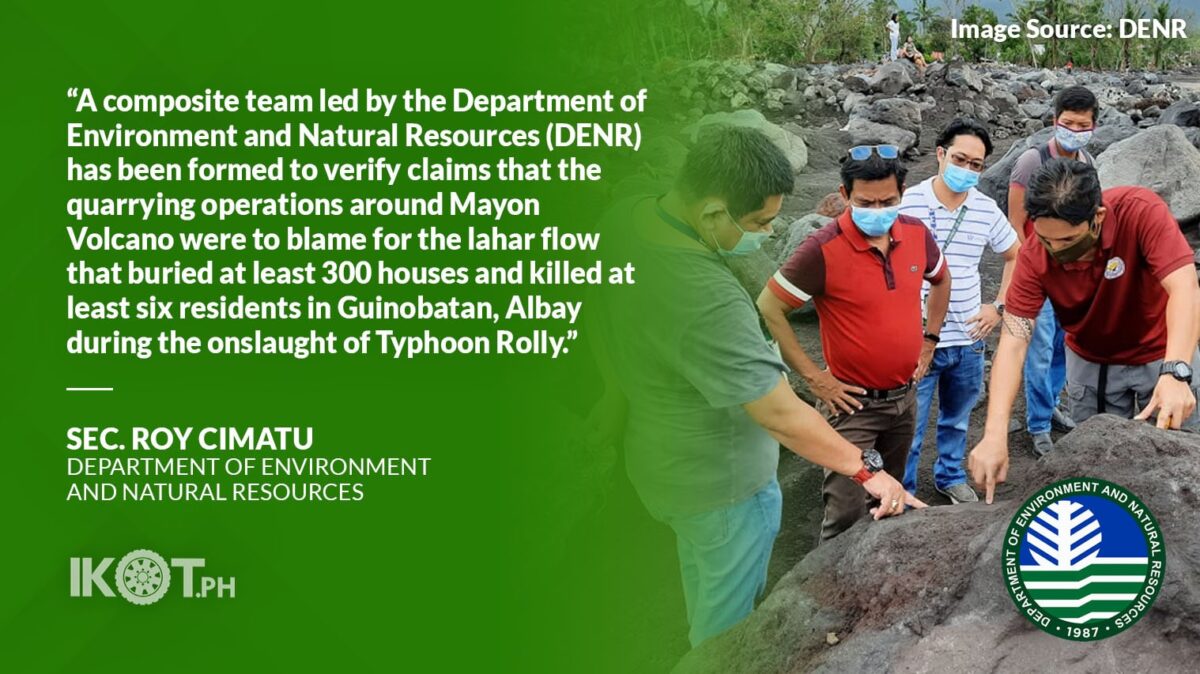A composite team led by the Department of Environment and Natural Resources (DENR) has been formed to verify claims that the quarrying operations around Mayon Volcano were to blame for the lahar flow that buried at least 300 houses and killed at least six residents in Guinobatan, Albay during the onslaught of Typhoon Rolly.
This was announced by DENR Secretary Roy Cimatu, a few days after he ordered the suspension of around 12 quarrying operations around the active volcano.
Cimatu said the team is composed of representatives from the Mines and Geosciences Bureau (MGB), Environmental Management Bureau, and the local government.
“The task force that we sent there is already working on the investigation. But I also directed one of my Undersecretaries and the MGB Director to go to Albay,” the environment chief said.
The environment head said that the investigation will examine quarrying operations within the perimeter of the volcano and will focus on the 12 quarrying sites that have been earlier identified.
“The concentration of the investigation is the culpability of these 12 quarrying sites which operate at the same river that there were casualties.”
“The concentration of the investigation is the culpability of these 12 quarrying sites which operate at the same river that there were casualties,” he said.
Cimatu added: “But I also want to look at quarrying operations around the volcano. Not only that particular area in Guinobatan.”
According to him, the temporary shutdown of the identified quarry sites will give time to the composite team to review the compliance of the operators on quarrying regulations.
“That’s why I announced a temporary halt of the operations, because we will look into it to prevent it from happening again in the future,” Cimatu explained.
“Due to the persistent rains and typhoons, we have to review the quarrying operations.”
“Due to the persistent rains and typhoons, we have to review the quarrying operations there so that if they are cleared, they can start their operations again if I have already checked their compliance on quarrying regulations,” he added.
Cimatu also mentioned that a regulatory board, known as the Provincial/City Regulatory Mining Board (PCRMB), manages quarrying operations in the provinces.
“All quarrying in the provinces is being managed by the regulatory board there composed of DENR, local government units, and other agencies of government in one province. The chairman of that is the Regional Director of MGB and the vice-chairman is the governor,” he said.
As stated in Section 70 of DENR Administrative Order No. 2010-21 or the Revised Implementing Rules and Regulations of Republic Act (RA) 7942, or the Philippine Mining Act of 1995, the PCRMB must be formed to “accept, process, and evaluate applications and determine administrative charges and fees for Quarry, Sand and Gravel, Guano, Gemstone Gathering, and Small-Scale Mining Permits duly filed.”
Members of PCMRB are composed of representatives from large-scale mining, small-scale mining, and non-government organizations.
However, he pointed out that the provincial governor also issues permits to quarrying operators, as stated in RA 7160 or the Local Government Code.
“The one that provides or gives to the quarry operators is the governor, it is his mandate na siya ang magbibigay ng permit, nasa local government code ‘yan,” Cimatu stressed.

